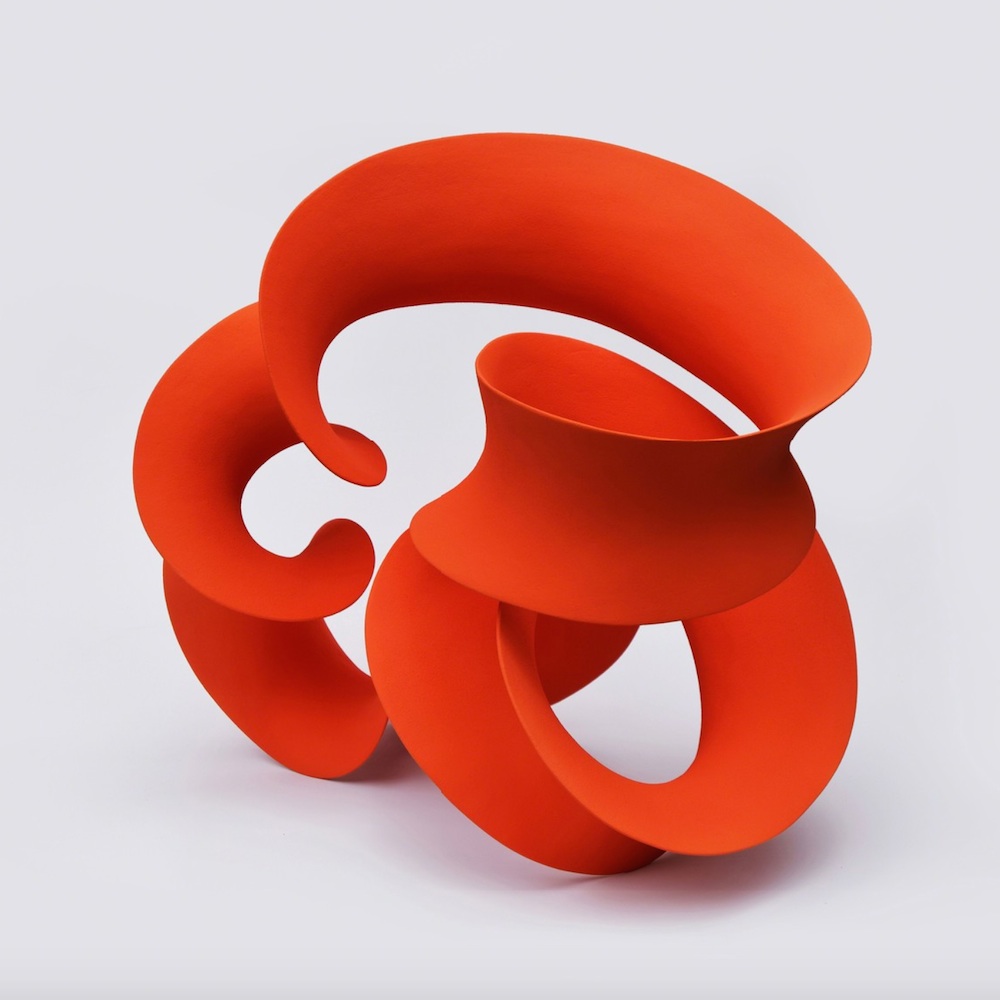Welcome to Spotted, our weekly roundup of the tastiest tidbits from the world of contemporary ceramics and contemporary ceramic art!
We’re starting off this week with these fabulous ribbon-like sculptures by London-based ceramist Merete Rasmussen. This Designskolen Kolding grad had this to say about her work:
Above image: Merete Rasmussen, Dark Orange Continuous Form, 2016, ceramic, 18 x 19 x 12 inches

Merete Rasmussen, Blue Entwined Form 2016, ceramic, 15 x 20 x 20 1/2 inches. Click to see a larger image.

Merete Rasmussen, Yellow Twisted Loop, 2016, ceramic, 19 1/2 x 19 1/2 x 15 inches. Click to see a larger image.

Merete Rasmussen, Grey Curved Form, 2016, ceramic, 12 1/2 x 15 x 12 inches. Click to see a larger image.
I am interested in the way one defines and comprehends space through physical form. My shapes can represent an idea of a captured movement, as a flowing form stretching or curling around itself, or the idea can derive from repeated natural forms or even complex mathematical constructions. Different form expressions appeal to me and results in my continuous exploration with many different variations: soft but precise curves, sharp edges, concave surfaces shifting to convex; the discovery and strength of an inner or negative space. I am intrigued by the idea of a continuous surface, for example with one connected edge running through an entire form.
3D Printed Columns by ELstudio
Is it just us or does 3D printing keep getting cooler? Amsterdam’s ELstudio for architecture and research just wowed us with pictures of this 3D printed column. It showed at the European Ceramic Workcentre in Oisterwijk. The column itself was made at a fabrication laboratory in Cove Park, Scotland.
We love the complexity of this column, like a mechanical pin in a clockworks that monitors something far more complicated than time. This proof of concept is so busy your eyes get sucked down into it like a whirlpool.
The studio states of its work:
Our design attitude is grounded on thorough research in fields such as architectural thinking, algorithmic design processes and sustainable urbanism. By defining strong concepts we produce clear designs. Our goal is to find simple structures which can translate and organize complex realities.
You can see more of the studio on Erno Langenberg’s Instagram account.
Shary Boyle on her Appearance at Venice Biennale, 2013
This interview is a few years old, but everyone should experience the fullness of Boyle’s work, including the sentiment that drives it. In this interview she talks about Venice as The Other, a haunted place, an Atlantis just before the waters claim their prize. She also messes with the brand of nationalism that runs through these biennials. She appeared in the Canadian booth. Confining the different artists to booths by country always seemed odd to me, a strange relic from something like The World’s Fair. If anything, it highlights the absurdity of imagined borders by grouping different artists together into little pavilions that have clear boundaries. I feel like many artists would take the chance to tear that idea down in a critique, but Boyle does better by taking nationalism and replacing it with something more filling.
There are clearly references to Canadian folklore in your work – but you’ve also got a very ironic take on the Canadian identity. I’m thinking, for example, of your piece “Canadian artist,” which was a response to you being described as such.
That’s right, no one knows what that means or what it is at all. Identity, cultural identity is an invented term that is about gathering as many examples of people that you feel the proudest about and claiming them as your ancestors. [For this piece] I just did three or four generations of an invented family tree for an invented self. There are a least 55 people involved, and I traced their bloodline with ribbons through the appropriate progenitors back to the individual that was “the artist.” It was extraordinary just to imagine the amount of genetics. We tend to claim one ancestor, but we are just all universal hobos, and we have to claim all of it.
Do you love or loathe these missives from the world of contemporary ceramics and contemporary ceramic art? Let us know in the comments.











Add your valued opinion to this post.